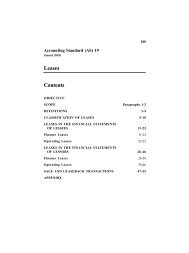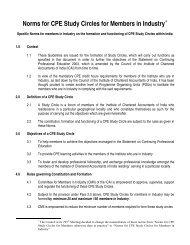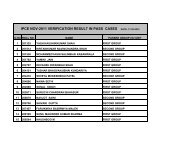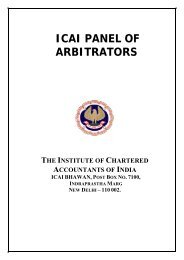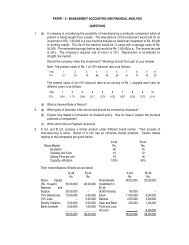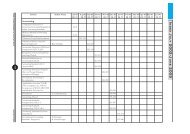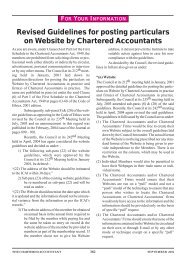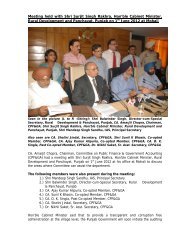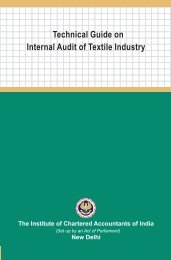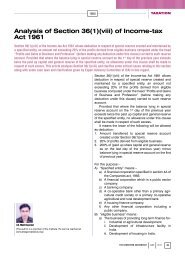The Chartered Accountant
The Chartered Accountant
The Chartered Accountant
You also want an ePaper? Increase the reach of your titles
YUMPU automatically turns print PDFs into web optimized ePapers that Google loves.
Standard for Local Bodies:<br />
(i) Interest for the period = USD<br />
10,000 x 5%x Rs. 48/USD =<br />
Rs. 24,000/-<br />
(ii) Increase in the liability towards<br />
the principal amount<br />
=USD10,000 x (48-45) = Rs.<br />
30,000/-<br />
(iii) Interest that would have resulted<br />
if the loan was taken in<br />
Indian currency = USD 10000<br />
x 45 x 11% = Rs. 49,500<br />
(iv) Difference between interest<br />
on local currency borrowing<br />
and foreign currency borrowing<br />
=Rs. 49,500 – Rs. 24,000<br />
=Rs. 25,500<br />
<strong>The</strong>refore, out of Rs. 30,000 increase<br />
in the liability towards principal<br />
amount, only Rs. 25,500 will be considered<br />
as the borrowing cost. Thus,<br />
total borrowing cost would be Rs.<br />
49,500 being the aggregate of interest<br />
of Rs. 24,000 on foreign currency<br />
borrowings (covered by paragraph<br />
4(a) of this Accounting Standard for<br />
Local Bodies) plus the exchange difference<br />
to the extent of difference<br />
between interest on local currency<br />
borrowing and interest on foreign<br />
currency borrowing of Rs. 25,500.<br />
Thus, Rs. 49,500 would be considered<br />
as the borrowing cost to be accounted<br />
for as per this Accounting<br />
Standard for Local Bodies and the<br />
remaining Rs. 4,500 would be considered<br />
as the exchange difference to<br />
be accounted for as per Accounting<br />
Standard for Local Bodies (ASLB)<br />
on ‘<strong>The</strong> Effects of Changes in Foreign<br />
Exchange Rates’ 5 . Guidance on<br />
accounting for the effects of changes<br />
in foreign exchange rates can be<br />
found in Accounting Standard (AS)<br />
11, ‘<strong>The</strong> Effects of Changes in Foreign<br />
Exchange Rates’, until the ASLB<br />
on this subject is formulated.<br />
5 <strong>The</strong> Accounting Standard for Local Bodies is under preparation.<br />
DECEMBER 2008 1084THE<br />
CHARTERED ACCOUNTANT<br />
STANDARDS<br />
In the above example, if the interest<br />
rate on local currency borrowings is<br />
assumed to be 13% instead of 11%,<br />
the entire exchange difference of Rs.<br />
30,000 would be considered as borrowing<br />
costs, since in that case the<br />
difference between the interest on local<br />
currency borrowings and foreign<br />
currency borrowings (i.e., Rs. 34,500<br />
(Rs. 58,500 – Rs. 24,000)) is more<br />
than the exchange difference of Rs.<br />
30,000. <strong>The</strong>refore, in such a case,<br />
the total borrowing cost would be<br />
Rs. 54,000 (Rs. 24,000 + Rs. 30,000)<br />
which would be accounted for under<br />
this Accounting Standard for Local<br />
Bodies and there would be no exchange<br />
difference to be accounted<br />
for under proposed ASLB on ‘<strong>The</strong><br />
Effects of Changes in Foreign Exchange<br />
Rates’.<br />
Appendix B<br />
Note: This Appendix is not a part<br />
of the Accounting Standard for Local<br />
bodies. <strong>The</strong> purpose of this appendix<br />
is only to bring out the major<br />
differences between this Accounting<br />
Standard for Local Bodies (ASLB)<br />
and the corresponding International<br />
Public Sector Accounting Standard<br />
(IPSAS) 5, Borrowing Costs issued<br />
by International Public Sector Accounting<br />
Standards Board.<br />
COMPARISON WITH IPSAS 5,<br />
BORROWING COSTS<br />
1. Capitalisation of Borrowing<br />
Costs<br />
IPSAS 5 prescribes the expensing<br />
of the borrowing costs as ‘benchmark<br />
treatment’. However, in relation<br />
to the borrowing costs directly<br />
attributable, (both specifically and<br />
generally incurred), to the acquisition,<br />
construction or production of a<br />
qualifying asset, it provides an option<br />
of capitalising such borrowing costs<br />
in the cost of that asset. Recently, In-<br />
ternational Public Sector Accounting<br />
Standards Board (IPSASB) has issued<br />
ED 35 that proposes amendments to<br />
IPSAS 5 which inter alia include that<br />
the borrowing costs related to general<br />
borrowings are not eligible for<br />
capitalisation.<br />
As compared to above, ASLB 4 does<br />
not prescribe expensing of borrowing<br />
costs as in IPSAS 5. It requires<br />
capitalisation of borrowing costs.<br />
However, keeping in view the initial<br />
stage of introduction of accrual accounting<br />
in Local Bodies, the ASLB<br />
4, ‘Borrowing Costs’, incorporates<br />
the amendments proposed in the<br />
ED 35 requiring that only those borrowing<br />
costs that are specifically incurred<br />
for the acquisition, construction<br />
or production of a qualifying<br />
asset should be capitalised as part of<br />
the cost of that asset. Thus, ASLB<br />
4 does not require capitalisation of<br />
borrowing costs arising from general<br />
borrowings as presently required in<br />
IPSAS 5.<br />
2. Substantial Period of Time<br />
IPSAS 5 does not provide the meaning<br />
of the expression ‘substantial period<br />
of time’. It provides only examples<br />
of the qualifying Asset requiring<br />
the substantial period of time. ASLB<br />
4 provides the interpretation of the<br />
expression ‘substantial period of<br />
time’. It provides that ordinarily, a<br />
period of twelve months is considered<br />
as substantial period of time<br />
unless a shorter or longer period can<br />
be justified on the basis of facts and<br />
circumstances of the case.<br />
3. Commitment Charges<br />
ASLB 4 provides that the Borrowing<br />
Costs may include commitment<br />
charges on bank borrowings. However,<br />
IPSAS 5 does not provide for<br />
including the commitment charges<br />
on bank borrowings.q



